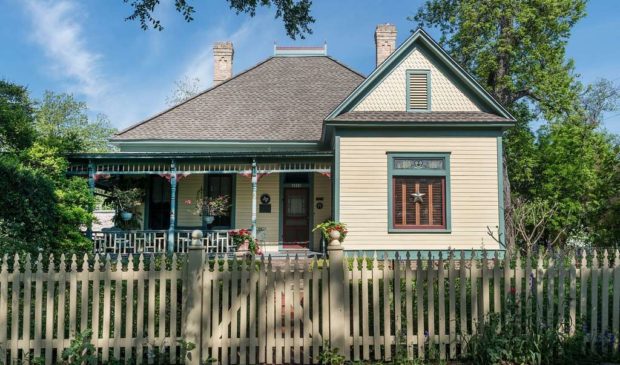Photo by The Lyda Hill Texas Collection of Photographs in Carol M. Highsmith's America Project, Library of Congress, Prints and Photographs Division.
Report: ADU expansion, tax relief among city’s options to promote preservation
Friday, January 20, 2023 by
Chad Swiatecki Preservation advocates want the city to simplify the process for building accessory dwelling units, and use an ombudsman position to help navigate city processes as some of the steps needed to save existing housing stock while helping to address affordability.
Those were some of the conclusions in a recent paper from Urban Land Institute Austin that looked at the programs and problems involved in the preservation movement while demand for local housing continues to surge.
The technical assistance report brought together more than 40 experts including city preservation staff, local business and property owners, planners and developers to make recommendations based on the findings that Austin loses its local character when long-standing homes are torn down.
The report also found demolition and new construction is often an easier and more lucrative option than preservation, noting: “At present, it is often an easier permitting path and more profitable for developers to tear down existing older homes, making way for new construction. The development process would benefit from the intentional alignment and comprehensive cooperation of the various city departments involved in preservation work, ensuring that the reviews and paperwork needed to support preservation efforts are as easy – if not easier – than demolition.”
The ability to create ADUs on the same property as a preservation-worthy home is seen as one of the best tools for the city to encourage owners to hold on to their homes while adding needed housing stock and possibly rental income to offset rising property taxes.
David Steinwedell, chair of the panel that wrote the report, said the city needs to improve and centralize more of its preservation tools involving maintenance assistance and tax relief to make them easier for non-developer owners to use.
“There are existing programs that are underutilized such as the repair program and homestead exemption. However, some existing options, such as ADUs are too complicated or expensive for many homeowners,” he wrote in an email after consulting with panel members.
“If the city grows relationships and trust with communities where displacement is occurring and provides an ombudsman as recommended in the report to help connect residents with programs or walk through complicated processes, that will help expand utilization of existing opportunities.”
Steinwedell’s group sees increased use of a community land trust as well as changes to homestead property tax exemptions as two possible remedies for property owners being priced out of their homes by rising property values. Further changes to assessment practices – including basing assessments on property rental income – would require the cooperation of Travis County and may be difficult to orchestrate.
Another problem the panel found was persistent distrust of the city by neighborhood groups throughout the area.
“A surprise was the lack of trust by residents and neighborhood groups in the city to fairly administer the programs. An often repeated fear was that using a city program would trigger inspections that would result in additional work being required that the resident didn’t have the funds to complete.”
Lindsey Derrington, executive director of Preservation Austin, said preservation of homes built before Austin became a boom town helps to keep longtime residents in the area while also creating options for first-time homebuyers who grew up here.
“(Preservation) has to be part of the equation for keeping longtime residents in place and giving first-time homebuyers more options for living in Austin’s central city neighborhoods,” she said. “Our Land Development Code, market forces and development processes make it easier to demolish existing and more affordable homes for newer, more expensive housing. We have to change this dynamic.”
Cara Bertron, a senior planner specializing in displacement prevention for the city, said redevelopment tends to result in denser clusters of homes unaffordable for most residents, while preservation and ADU expansion can help address the city’s affordability problem.
“It’s easy to overlook that many older houses are market-affordable now, so preserving them is an important part of a citywide affordability strategy. In terms of new construction, accessory dwelling units behind existing homes can help to create more affordable housing in the context of existing neighborhoods, especially with more technical and financial support for homeowners.”
Read the full report here:
Download (PDF, 14.27MB)
The Austin Monitor’s work is made possible by donations from the community. Though our reporting covers donors from time to time, we are careful to keep business and editorial efforts separate while maintaining transparency. A complete list of donors is available here, and our code of ethics is explained here.
You're a community leader
And we’re honored you look to us for serious, in-depth news. You know a strong community needs local and dedicated watchdog reporting. We’re here for you and that won’t change. Now will you take the powerful next step and support our nonprofit news organization?







